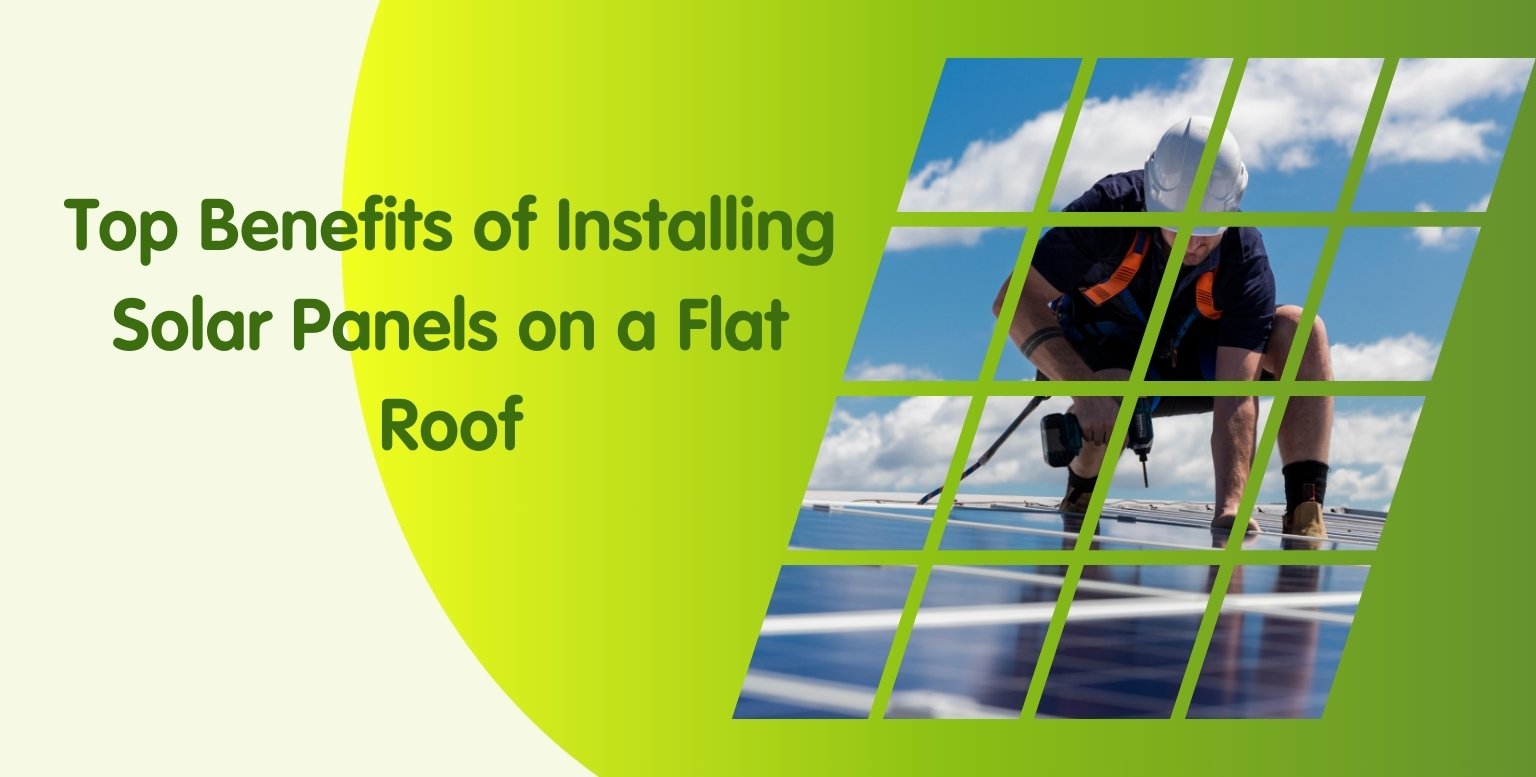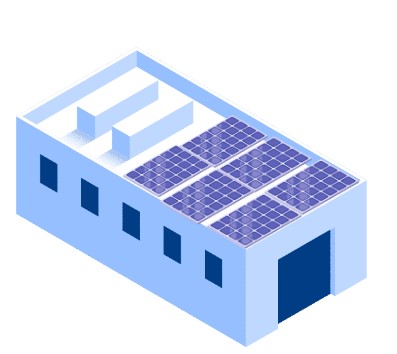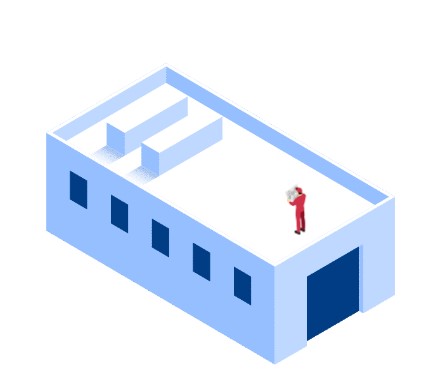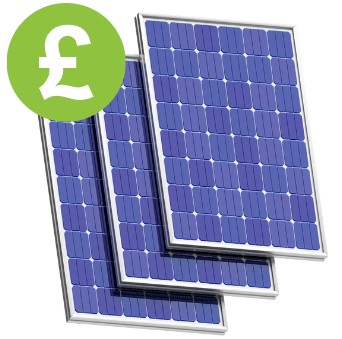Your basket is currently empty!
Written by
Flat Roof Solar Panels Installation Costs & Benefits

There are many types of different homes and buildings in the UK, and if you don’t have a pitched roof then do not worry you can install solar panels on a flat roof.
This article explains the top benefits, the solar panel installation process, and costs involved.
Start Your Solar PANEL Project Today
Buy 1 get 1 FREE Solar Panels With Installation!
Solar Finance Options & Price Match Too!
Key Takeaways
- Flat roofs provide a versatile and effective surface for solar panel installations, allowing for optimal angles and maximising sunlight absorption.
- Installing solar panels on flat roofs typically involves simpler and safer processes, but careful structural assessments and mounting systems are crucial for stability and performance.
- Homeowners can benefit financially from installing solar panels on flat roofs through long-term savings on energy bills and potential government grants, while enjoying eased planning regulations.
Installing Solar Panels on a Flat Roof

Flat roofs present a unique opportunity for solar panel installations.
Unlike sloped roofs, flat roofs provide a versatile surface that can often result in equal or superior performance.
However, there are critical factors to consider to ensure that the roof is suitable for solar panel installation and is both practical and beneficial.
Firstly, the roof must withstand strong winds and have adequate drainage to avoid potential damage.
Although flat roofs require more space than sloped ones, they allow for adjustable panel angles to capture optimal sunlight.
Consulting with experienced industry experts is crucial for addressing all installation aspects.
Despite the challenges, flat roofs are a viable surface for solar panels and can significantly contribute to a building’s energy needs.
With careful planning and execution, flat roof solar systems can be just as efficient, if not more so, than their sloped roof counterparts.
Optimal Mounting Systems for Flat Roofs
The mounting system’s role in ensuring stability and performance is crucial.
Ballasted mounting systems are popular because they avoid roof penetrations, reducing the risk of leaks.
They use materials like sand, gravel, or cement to weigh down the panels, providing stability and balance.
Another effective solution is using adjustable metal frames that allow the panels to be tilted at the desired angle.
This flexibility maximises sunlight absorption and improves overall efficiency.
Ballast mounts and metal frames provide robust solutions for mounting solar panels on flat roofs, simplifying and making the installation process more efficient.
These specialised systems ensure that the panels remain secure and perform optimally throughout their lifespan.
Structural Considerations
Assessing the roof’s structural integrity is crucial before installing solar panels on a flat roof, such as installing solar panels on a garage roof.
The roof must support the additional weight of the panels and mounting systems, which can be significant.
For instance, ballasted solar panels can weigh up to five times more than non-ballasted panels, posing a considerable load on the roof.
Most residential flat roofs aren’t designed to support such heavy loads, necessitating thorough structural assessments to determine if reinforcements are needed. However, it is possible to install solar panels on a pergola or similar structure, so a flat roof will be fine.
A structural engineer may be required to evaluate the roof’s capacity and ensure it can safely support the solar panel installation.
Understanding these considerations is crucial to avoid compromising the roof’s integrity and ensuring a successful installation.
Installing Flat Roof Solar Panels
The installation process for flat roof solar panels involves several critical steps to ensure the system is secure and efficient.
An experienced installer can navigate the unique challenges of flat roof installations.
The process typically includes a site assessment, panel mounting, and system commissioning.
Installing solar panels on flat roofs is generally safer and simpler than on sloped roofs because it requires no special equipment and poses fewer risks.
However, expert advice is recommended to ensure the installation is carried out correctly and efficiently.
Site Assessment and Preparation

A thorough site assessment is the first step in the installation process. The roof’s condition must be checked to ensure it’s in good shape and can support the solar panels.
Roofs over 10 years old may need replacement before installation.
Additionally, the lifespan of traditional felt used for flat roofs is approximately 15 years, which could indicate a need for replacement.
During the assessment, the installer will evaluate potential shading issues from nearby buildings or trees and measure the roof to determine the number and size of panels required.
A structural survey ensures the roof can handle the additional weight of the solar panels and mounting systems.
Homeowners should contact a reliable professional to assess their roof’s suitability for solar panels.
Summarising the findings and necessary preparations ensures a successful installation.
Mounting and Securing Solar Panels
Mounting and securing solar panels on a flat roof involves maintaining proper spacing and ensuring stability.
Keeping about one metre between rows of panels prevents shading and allows for maintenance access.
Additionally, panels should be installed at least 0.5 to 1 meter away from the edge of the roof to comply with building regulations.
Securing the panels is crucial to withstand strong winds, which can pose a significant threat to flat roof installations.
Ensuring the roof can support the weight of the panels, often verified through a structural survey, is essential for the stability and longevity of the installation.
Connecting and Commissioning the System
The final step is connecting the solar panel system to the electrical grid.
This involves using an inverter to convert the DC power generated by the panels into AC power for home use.
Commissioning the system includes testing for functionality and performance to ensure all components are operational.
Once operational, the system should be registered with the local utility provider to start receiving incentives and ensure compliance with local regulations. This step maximises the benefits of your solar panel installation and ensures everything is up to code.
If you are installing panels on a flat roof for an outbuilding, you could make it an off-grid solar installation system if your sole purpose is to power that building on its own.
Cost of Installing Solar Panels on a Flat Roof
The cost of installing solar panels on a flat roof can vary widely depending on several factors. On average, the cost is around £825 per kW, with total costs ranging from £2,500 to £10,500, including installation.

Factors such as the number of panels you need, type of mounting system, and any necessary roof repairs can influence the total cost.
Installing solar panels on flat roofs can be more cost-effective due to simpler installation processes and easier maintenance, leading to lower labour costs.
However, additional costs for mounts, drainage solutions, and structural supports should be considered.
Equipment and Material Costs
The cost of equipment and materials for a typical 4kW solar panel system is around £5,000 to £6,000 which is why we offer finance for solar panels to help spread the cost.
The starting price for solar systems in the UK is approximately £3,500. Additional components like solar batteries, which can range from £2,500 to £10,000 depending on type and capacity, are not always included in the initial estimate.
Racking for solar panels on a flat roof typically accounts for about 3% of the total system cost, while labour and safety equipment represent around 10%.
These costs are essential to consider when planning your installation.
Labour and Installation Costs
Labour costs for installing solar panels on flat roofs generally account for about 10% of the total installation cost.
These costs can vary based on the complexity of the installation and the experience of the installers.
Compared to pitched roofs, flat roofs may have different labor considerations, potentially affecting overall installation costs.
However, the simpler and safer installation process on flat roofs often leads to lower labor costs overall.
Potential Additional Expenses
Additional expenses for installing solar panels on flat roofs can arise from structural requirements, regulatory compliance, and potential planning permission costs.
Flat roof solar fixings can add to the cost because they often require specialised mounting systems to ensure the panels are angled correctly for optimal sunlight exposure.
These mounting structures can be more complex and expensive than those used for sloped roofs, increasing both material and installation costs.
Additionally, extra components like ballast or anchoring systems may be needed to secure the panels against wind and weather conditions.
Homeowners should also consider the potential need for roof repairs to support the weight of the system, which can increase the overall cost.
Planning for these additional expenses is crucial to avoid surprises during the installation process.
Efficiency and Performance of Flat Roof Solar Panels
The efficiency and performance of flat roof solar panels depend on several factors, including the angle, orientation, and shading.
The ideal pitch for solar panels on a flat roof in the UK is between 20 to 40 degrees, allowing for maximum sun exposure.
Installing the panels at a minimum of 10 degrees enhances both sunlight capture and self-cleaning capability.
Proper orientation is also crucial.
For optimal energy production, solar panels should be oriented south facing to receive maximum solar radiation throughout the day.
Preventing shading from nearby structures or trees is vital to maintaining the efficiency of flat roof solar panels.
Ideal Angles and Orientation
The optimal angle for mounting solar panels on flat roofs is generally around 10 degrees to reduce wind uplift.
While achieving an ideal installation angle of 35 degrees is often impractical due to wind exposure and structural constraints, a 10-degree angle is a good compromise for balancing performance and installation cost.
Flat roofs enable the positioning of solar panels at various angles to optimise sunlight capture throughout the year.
A flat roof solar system requires correct positioning and angle, which are crucial for maximising solar energy capture on flat roofs.
Shading and Space Utilisation
Proper shading management is essential for optimising the performance of solar panels on flat roofs.
Shading can significantly reduce efficiency, making effective management a priority for maximum energy capture.
East/west configurations can optimise space usage on flat roofs by allowing panels to be placed back-to-back, maximising the available roof space.
Successfully managing shading and optimising space utilisation can lead to improved energy production and efficiency for solar panels.
Seasonal Performance Variations
The performance of flat roof solar panels can vary with the seasons due to changes in sunlight availability and weather conditions.
Understanding these variations helps in planning and optimising the solar panel system to ensure consistent performance throughout the year in the solar system.
Benefits of Solar Panels on Flat Roofs
Installing solar panels on flat roofs offers numerous benefits, making it an attractive option for many property owners.
One primary advantage is the easier installation process compared to sloped roofs. The flat surface simplifies the mounting and alignment of panels, making it a straightforward project.
Additionally, flat roofs offer ample space for solar panel arrays, allowing for more extensive installations that can generate significant amounts of energy.
Another significant advantage is the flexibility in panel orientation.
Flat roofs allow panels to be adjusted to the optimal angle for sunlight capture, improving their efficiency.
This flexibility ensures that the panels receive maximum solar radiation throughout the day, enhancing energy production.
Moreover, the aesthetic appeal of flat roof solar panel array installations is a significant advantage.
Panels can be positioned to minimise visibility from the street, maintaining the building’s appearance while integrating renewable energy solutions.
Easy Maintenance and Access
One standout advantage of installing solar panels on flat roofs is the ease of maintenance and access.
The flat design allows for straightforward access, making cleaning and maintenance tasks simpler and more cost-effective.
Unlike sloped roofs, where accessing panels can be challenging and hazardous, flat roofs provide a safe and convenient platform for regular upkeep.
This ease of access translates to lower maintenance costs over time.
Homeowners can easily inspect and clean their panels, ensuring optimal performance without the need for specialised equipment or professional services.
Additionally, flat roofs offer more space to maneuver during maintenance, making it easier to upgrade or remove the system if necessary.
Flexible Panel Orientation
The flexibility in panel orientation is another significant benefit of flat roof solar panels.
Unlike sloped roofs, which have fixed angles, flat roofs allow for panels to be oriented in line with the building’s footprint, maximising the number of panels installed and minimising wasted space.
This flexibility ensures that panels can be positioned to capture the most sunlight throughout the day, enhancing their efficiency and energy production.
Different orientation strategies, such as east/west configurations, can yield better overall performance per square meter compared to traditional south-facing setups.
Additionally, mounting panels at a lower angle reduces the need for ballast, which is beneficial for roofs that cannot support heavy weights.
This adaptability makes flat roof systems solar installations more versatile and efficient, catering to various building designs and energy needs.
Aesthetic and Discreet Installation
Flat roof installations of solar panels offer aesthetic advantages that enhance the property’s overall appearance.
Panels can be positioned to minimise visibility from the street, making them less intrusive and more integrated into the building’s architecture.
This discreet installation ensures that the property retains its visual appeal while benefiting from renewable energy solutions.
Additionally, the lower profile of flat roof solar panels means they are less likely to be seen from ground level, reducing any potential visual impact.
This aesthetic benefit is particularly valuable for properties in conservation areas or those with strict aesthetic guidelines.
By installing solar panels on a flat roof, homeowners can enjoy the benefits of solar energy without compromising the appearance of their property.
Challenges and Solutions for Flat Roof Solar Panels
While flat roof solar panels offer numerous benefits, they also come with unique challenges that need to be addressed.
These challenges include structural integrity, weight concerns, and potential wind resistance. Ensuring the roof is in good condition before installation is crucial, as post-installation repairs can be more complex and costly.
Choosing an experienced installer can help navigate these challenges effectively.
Identifying potential obstacles early in the process is essential for a successful installation.
By addressing these issues during the planning and installation phases, homeowners can ensure their flat roof solar systems perform optimally and safely.
Wind Resistance and Stability
Wind resistance is a significant concern for solar panels on flat roofs.
Because the panels are elevated above the roof surface, they are more susceptible to dislodgement during high winds.
To counter this, panels can be secured using stable metal frames or by weighing them down with ballast frames, which use materials like heavy slabs, sand, gravel, or cement.
Addressing wind resistance is crucial to ensure the safety and efficiency of solar panels installed on flat roofs.
Properly securing the panels helps prevent them from being blown off during storms, maintaining their structural integrity and performance.
Water Drainage and Leak Prevention
Proper water drainage is vital for flat roof solar installations.
Without adequate drainage, rainwater can pool on the panels, leading to potential damage and leaks.
Installing drainage devices or adjusting the panel angle can effectively prevent water from collecting on the panels, ensuring their longevity and performance.
Pooling water can cause irreparable damage to solar panels and increase the risk of leaks, especially with ballasted systems that require drilling into the roof.
Ensuring proper drainage and leak prevention measures are in place is essential for maintaining the integrity of the solar panel system and the roof itself.
Weight and Structural Integrity
Installing solar panels on flat roofs adds additional weight, which can impact the structural integrity of the roof if not properly managed.
Higher mounting equipment costs and ballasts, costing £60 to £120 per kilowatt, may be necessary to support the weight of the panels and ensure roof stability.
Thorough assessments of the roof’s structural strength should be conducted before installation to mitigate these risks.
Understanding the impacts and costs associated with added weight, along with implementing measures to safeguard structural integrity, is crucial for safe solar panel installation on flat roofs.
Proper planning and reinforcement can ensure the roof can support the system without compromising its stability.
Planning Permission and Regulations
Planning permission is a critical consideration for homeowners thinking about installing solar panels on flat roofs.
However, under permitted development rights, planning permission is typically not required for flat roof installations, making the process more straightforward.
This regulatory ease is a significant advantage for those looking to adopt solar energy without the hassle of lengthy approval processes.
It’s important to note that exceptions exist. For example, homeowners may need planning permission if their property is listed or located in a conservation area.
Before starting the installation, contacting the local planning authority for guidance is advisable to ensure compliance with all regulations.
Current Planning Permission Rules
As of December 2023, planning permission is typically not required to install solar panels on flat roofs under permitted development rights. However, there are exceptions.
Properties that are listed or near listed buildings, as well as those in conservation areas, may require planning permission.
Before beginning the installation process, homeowners should contact their local planning authority and check the planning portal for specific guidelines and requirements.
This ensures that the installation complies with all relevant regulations and avoids potential legal issues.
Compliance with Local Regulations
Ensuring compliance with local building codes and regulations is crucial for the successful installation of solar panels.
Following these steps helps meet safety standards, minimises risks, and ensures the system is integrated with the electrical grid properly.
Compliance with local regulations not only ensures the safety of the installation but also maximises the benefits of the solar panel system.
Financial Incentives and Savings
Installing solar panels on flat roofs can lead to significant financial advantages, including regulatory ease and reduced energy costs.
There are numerous financial incentives available for homeowners considering solar panel installations, making the investment more attractive and affordable.
Recent changes in UK regulations simplify the process by eliminating the need for planning permission for flat roofs, provided specific guidelines are followed.
These incentives, combined with the long-term savings on electricity bills, make solar panel installations a financially sound decision.
Homeowners can enjoy reduced energy costs and contribute to a greener environment, making solar energy a win-win solution.
Government Grants and Subsidies
Government grants and subsidies play a crucial role in making solar panel installations more affordable for homeowners.
In the UK, specific grants aimed at reducing the financial burden of solar panel installations are available.
The ECO4 scheme, for example, provides funding for eligible households, covering significant installation costs.
Additionally, the Home Upgrade Grant can offer up to £10,000 to energy-inefficient homes for solar panel installation.
These financial aids make it easier for homeowners to invest in renewable energy, leading to long-term savings and environmental benefits.
Long-Term Savings on Electricity Bills
One of the most compelling reasons to install solar panels is the long-term savings on electricity bills.
Annual savings from a typical solar pv panels system can range from £80 to £230 for households.
For a typical three-bedroom home, these savings can be even more significant, potentially reaching approximately £454 annually.
As electricity bills continue to rise, the long-term savings from solar panel installations offer financial relief and stability.
By reducing reliance on grid electricity, homeowners can lower their energy bills and enjoy the benefits of renewable energy.
Payback Period and ROI
The payback period for solar panels can vary based on the household’s electricity usage.
On average, the payback period is around 15.46 years for a typical installation. This means that homeowners can recoup their investment within this period through savings on electricity bills.
After the payback period, solar panel installations can yield returns over a 25 to 30-year lifespan, generating profits and further reducing energy costs.
Investing in solar panels is not only an environmentally conscious decision but also a financially prudent one, offering significant returns over time.
Summary
In summary, installing solar panels on flat roofs offers numerous benefits, including easier installation, flexible orientation, and aesthetic advantages.
Despite the challenges such as wind resistance, drainage, and structural integrity, the solutions available make flat roof installations a viable and effective option for harnessing solar energy.
With careful planning and expert guidance, homeowners can maximise the efficiency and performance of their solar panel systems.
Financial incentives and long-term savings on electricity bills further enhance the appeal of solar panel installations.
By taking advantage of government grants and subsidies, homeowners can reduce the initial costs and enjoy significant returns on their investment.
Embracing solar energy is not only beneficial for the environment but also a sound financial decision.
Now is the time to transform your flat roof into a source of renewable energy and reap the rewards for years to come.
Frequently Asked Questions
Do I need planning permission to install solar panels on a flat roof?
You typically don’t need planning permission to install solar panels on a flat roof, as long as your property isn’t listed or in a conservation area. Just double-check your local regulations to be sure!
What are the benefits of installing solar panels on a flat roof?
Installing solar panels on a flat roof is a smart choice because it allows for easier installation and maintenance, plus you can adjust the orientation for optimal sunlight exposure. This setup also offers a clean aesthetic, adding value to your property.
How much does it cost to install solar panels on a flat roof?
Installing solar panels on a flat roof typically costs between £2,500 and £10,500, influenced by the number of panels and any required roof repairs. It’s a worthy investment that can lead to long-term savings!
How long does it take to recoup the investment in solar panels?
On average, you can expect to recoup your investment in solar panels in about 15.5 years. After that, they can keep saving you money for another 25 to 30 years!
What are the key considerations for installing solar panels on a flat roof?
When installing solar panels on a flat roof, be sure to consider the roof’s structural integrity, shading, wind resistance, and how water will drain off. These factors are essential for ensuring the system functions effectively and remains safe over time.
Written by
Start Your Solar PANEL Project Today
Buy 1 get 1 FREE Solar Panels With Installation!
Solar Finance Options & Price Match Too!
What is in this article?
- Key Takeaways
- Installing Solar Panels on a Flat Roof
- Installing Flat Roof Solar Panels
- Cost of Installing Solar Panels on a Flat Roof
- Efficiency and Performance of Flat Roof Solar Panels
- Benefits of Solar Panels on Flat Roofs
- Challenges and Solutions for Flat Roof Solar Panels
- Planning Permission and Regulations
- Financial Incentives and Savings
- Summary
- Frequently Asked Questions





